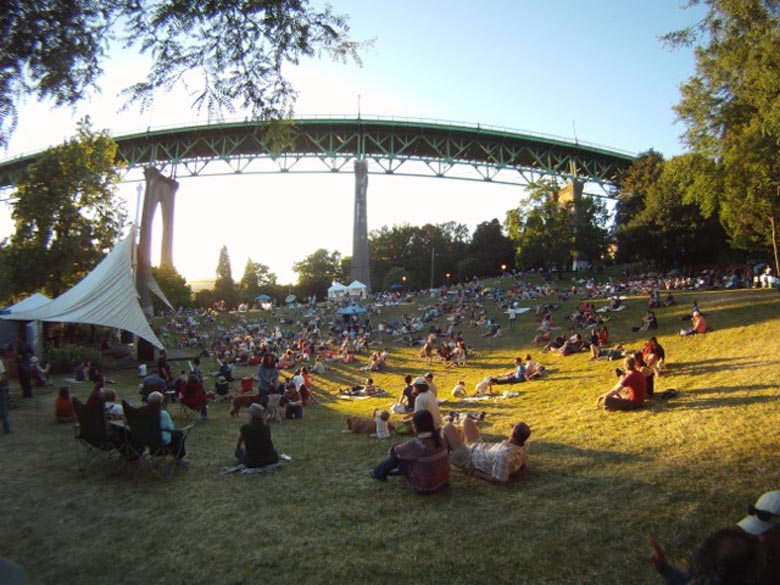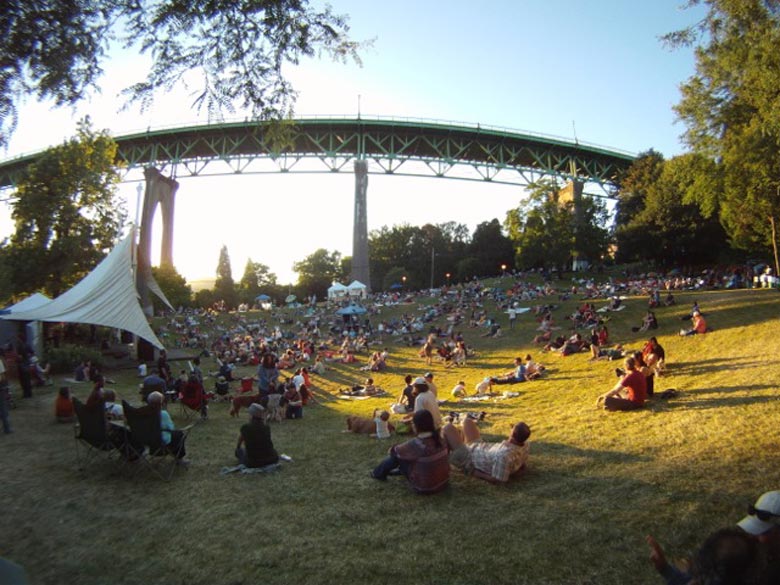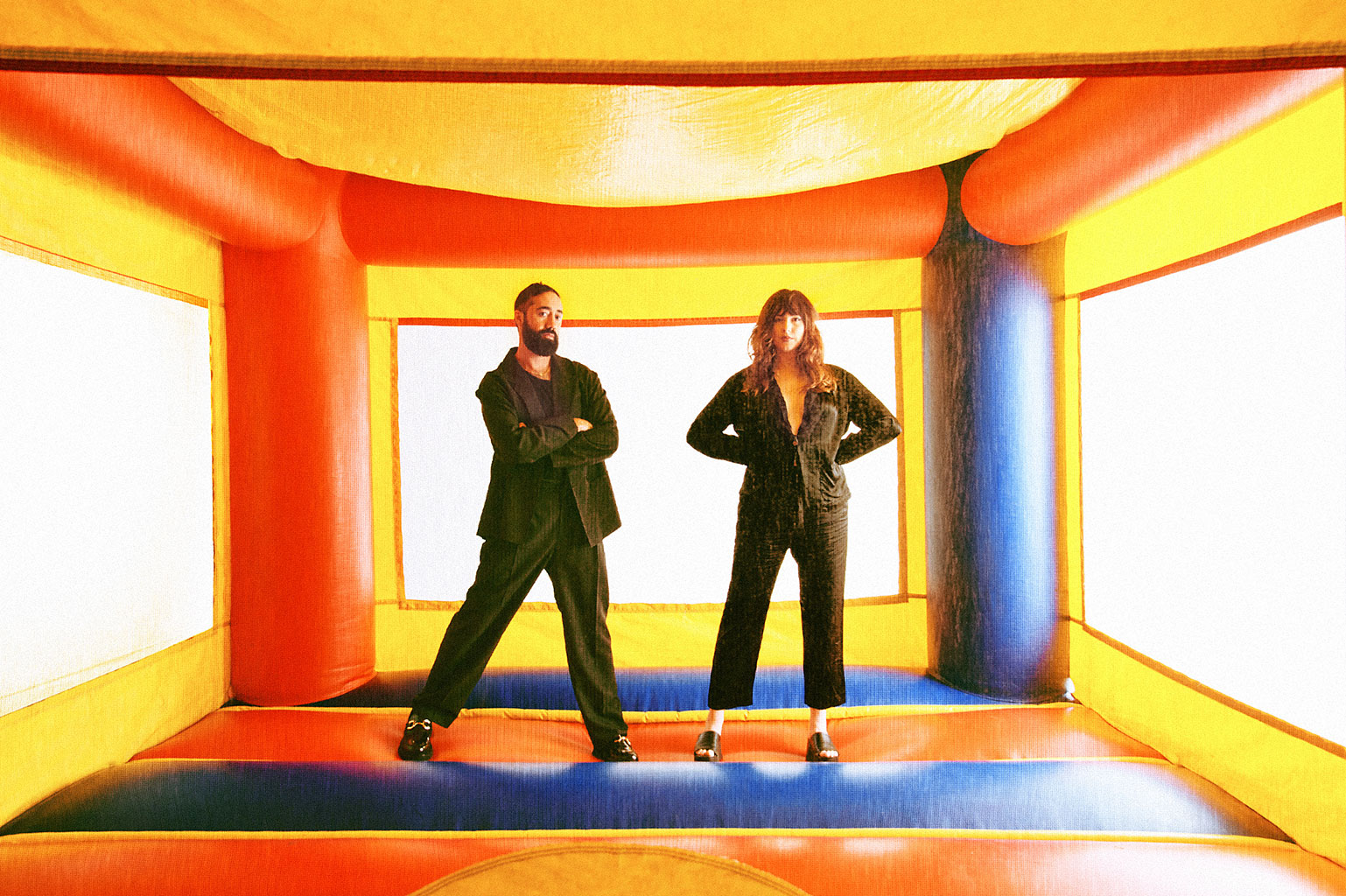I must confess, with some embarrassment, that this year was the first time attending the Cathedral Park Jazz Festival, and this has been much to my regret. The festival is held in the St. Johns neighborhood of Portland underneath the St. Johns Bridge and is the longest-running free jazz festival on the West Coast. “Free” is a bit of a pun here; the festival is both free to attend and also because it highlights the work of free jazz musicians. At the risk of painting with broad strokes, free jazz can best be defined as jazz in which “the rules” have been eliminated: set chord changes and a fixed rhythm are gone. It’s a sub-genre that has inspired a lot of controversy among jazz fans, but is also deeply loved by many.
I go on a Sunday evening, which is the last day of the festival. The atmosphere is, appropriately enough, like a festival, and there are concessions booths, signups for a jazz camp and informative areas around the park. What immediately jumps out at me is the number of families at this event; free jazz isn’t necessarily thought of as accessible music, let alone kid-friendly, yet there seem to be a lot of younger kids hanging around. This is why jazz festivals are so relevant, especially when they’re organized in a specific neighborhood: they sustain popular interest in an art form that risks becoming a museum piece otherwise, and that interest comes from people who might not be interested in jazz.
July 21st, 2013 – Cathedral Park Jazz Festival at St. Johns Cathedral Park – Portland, OR
Before I delve into the music of The Blue Cranes, the first band I saw, let me qualify myself by saying that I am fairly picky when it comes to listening to free jazz. I like the genre, but there are times when the atonality and the dissonance is a little too much for me. My favorite free jazz musician remains Pharoah Sanders. During the height of his free jazz period, Sanders’ music was deeply spiritual and rooted in creating a powerful sound through polyphony than harsh overblowing. There were solos, but the focus was predominantly on the group effort. The music wasn’t, and isn’t, reduced to an intellectual abstraction about what limits can be pushed, but is about stripping away barriers and conventions that limit expression.
The Blue Cranes turn out to be exactly what I like about free jazz. The lineup consists of an alto and tenor saxophone, a keyboard, a drummer and a bassist. Their music tends to be hypnotic to listen to, especially as the alto and tenor play in similar musical ranges, making the horns sound as one unified instrument. The sound is nothing if not hypnotic, even with some of the harsher sounds that the musicians make, and I couldn’t actually tell you how long some of the songs beyond that they were longer than five minutes. The dissonance and overblowing you find in other artists was used effectively to inject emotion into a song rather than simply dominating it. Here is where free jazz hits its peak: you can sit back and simply let your mind wander amid the song, seeing where the music might lead you. The Blue Cranes clearly have a good time and encourage a sort of audience participation; a couple of young children are given a toy marimba and allowed to just play on it while the band accompanies them.
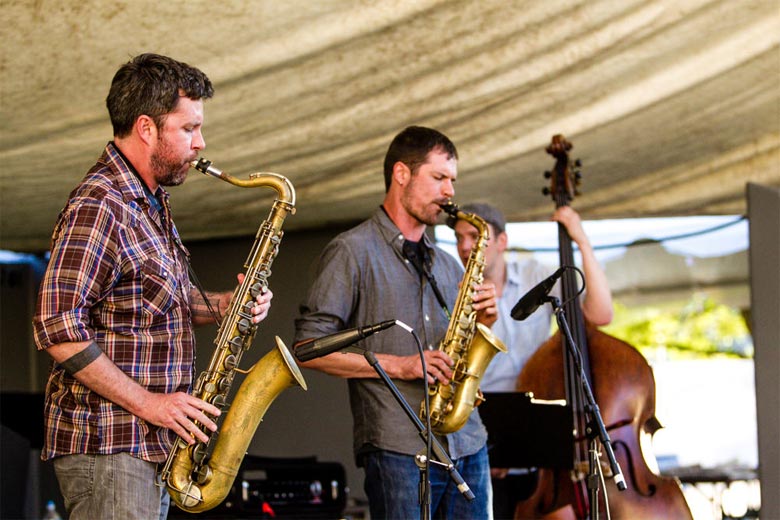
THE BLUE CRANES – Photography by Jason E. Kaplan
The Cathedral Park Jazz Festival ends when their set ends, and people make their way over to a place called the Colony for an after-show. The following show is a true improv experience, consisting of different musicians from different groups: Eri Yamamoto on piano; members of the Blue Cranes and their other band, Battle Hymns & Gardens (giggle); local trumpeter Farnell Newton. None of these musicians have ever played together as a group before, making the whole encounter free-form. It begins with Yamamoto on piano and Tim DuRoche, the drummer for Battle Hymns & Gardens, accompanying her. Drummer here is used loosely, as he avails himself of numerous different percussion items and noisemakers, including a bass bow rubbed on the edge of his cymbals. They are then joined by Farnell Newton on trumpet and play as a trio with Farnell now dominating the group. Farnell growls, roars, grows quiet, and plays with the keys of his trumpet to produce unorthodox sounds as the other two play behind him.
Finally, Battle Hymns & Gardens bassist Jon Shaw and the saxophonists from the Blue Cranes join in, making the improv unit a six-person group. Here, I think, the improv hits its peak; the six musicians create a sort of wall of sound, true polyphony. Despite being a mass of sound, though, it never descends into cacophony. The better analogy might be that of a wave which ebbs and flows in volume and tempo. The music calms and becomes less emotional as it is driven by the saxophonists, instead evoking a hypnotic quality. Following rhythm changes in a group of six players is a fascinating exercise for a non-musician such as me, because the tempo accelerates or slows periodically but is still present throughout each song. After a little while, Yamamoto leaves, and the group resumes, devoting one jam to solos — though this was more of a call and response between the musicians.
All in all, the jam session lasts an hour or so before wrapping up. The Cathedral Park Jazz Festival bucked some of my expectations, especially in terms of its younger demographics, and the lineup has given me a few new names to chase down. The Blue Cranes and Battle Hymns & Gardens are names to keep an eye on in the future for Oregonians, but the festival attracts talent from across the country as well. It’s encouraging to see that the festival attracts such strong local and national talent, and it’s doubly encouraging seeing it succeed with people my own age. In July of 2014, I know what I’m doing with one of my weekends in July.
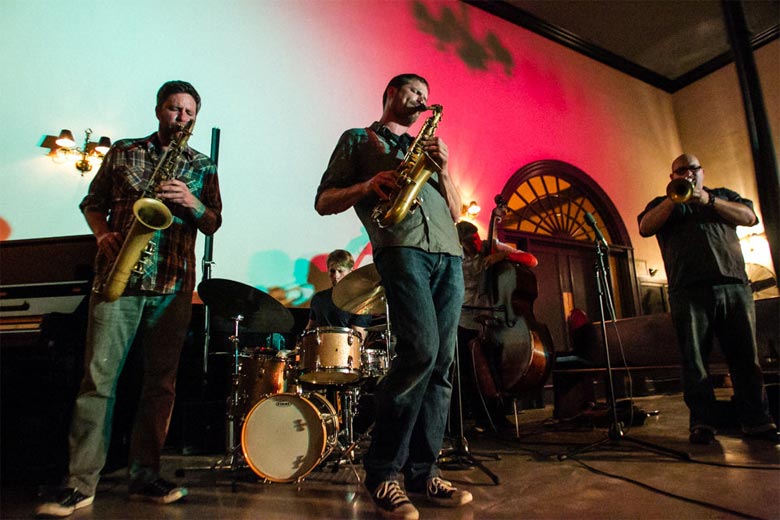
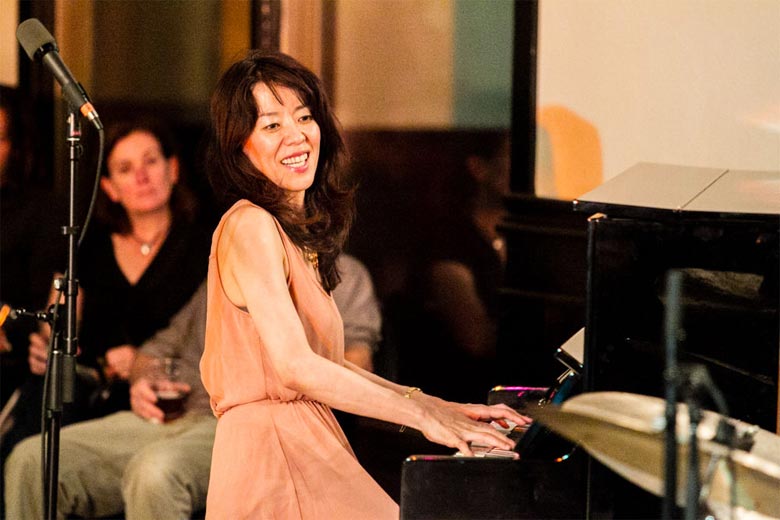
FINALE IMPROV CONCERT – Photography by Jason E. Kaplan
Ω

